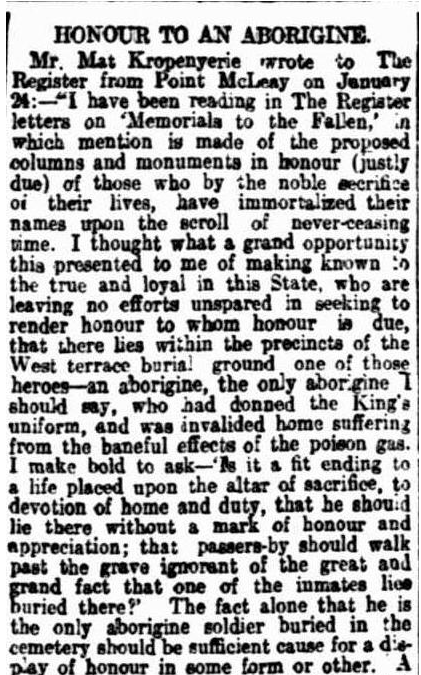Honouring Private Miller Mack
The first thing most people notice about this striking photograph of Ngarrindjeri Anzac Private Miller Mack is his eyes; the second is that he is an Aboriginal man. The photograph is often used as a symbol of Indigenous Australians’ contribution to the First World War. In this year’s National Reconciliation Week Last Post Ceremony, the Memorial shared the story of the man behind the photograph: a story of service, sacrifice, and the righting of wrongs nearly a century in the making.
Miller Mack was one of 21 Ngarrindjeri men from the Point McLeay Mission (now known as Raukkan) and the surrounding region to enlist for service in the Australian Imperial Force during the First World War. He joined up with his mates Francis Alban Varcoe and Clifford Tony Wilson in August 1916, despite military restrictions still officially barring Indigenous service. Of the three friends, only Clifford would go on to survive the war.

Private Francis Alban Varcoe was killed in action at Bullecourt on 5 May 1917. Chronicle (23 June 1917), 26.
Miller Mack returned to Australia from the Western Front in September 1917, suffering from tuberculosis of the lung. Around 2,000 Australian soldiers were sent home suffering from tuberculosis. Once the men reached Australia, they were admitted to specialised tuberculosis hospitals and sanatoriums established across the country to treat the men and protect the civilian population from the disease.

Bedford Park Sanatorium, where Miller Mack spent most of his final months. State Library of South Australia B55498.
Miller Mack died from tuberculosis in September 1919 in an Adelaide hospital, 150 kilometres away from his home at Raukkan. Likely on the instruction of the South Australian Aborigines Department, he was buried in a small, unmarked pauper’s grave in Adelaide’s West Terrace Cemetery.
Over the next 98 years, Miller Mack’s family and descendants fought for his remains to be given the recognition and respect they deserved.

Graves were gradually unveiled throughout the 1920s and 1930s in the new military section of West Terrace Cemetery. State Library of South Australia PRG 280/1/37/134.
When the formal military section of West Terrace cemetery opened in 1920, Miller’s remains were not moved into the space set aside for men of the 50th Australian Infantry Battalion
That same year, his uncle wrote to the local newspaper requesting public donations towards a headstone to honour Miller’s military service. The Bedford Park Sanatorium – where he had spent much of his time between returning to Australia and his death – contributed money towards the planned headstone. A representative of the hospital wrote to the local newspaper:
“While he was in this institution, by his kindly and manly nature, he endeared himself to us all, and when he ‘went went’ we felt that we had lost a dinkum pal. Those of us who knew him in camp and abroad can testify to his sterling qualities as a soldier and a man.”
A grave marker was eventually provided by the Office of Australian War Graves, and Miller’s name and burial details were registered with the Commonwealth War Graves Commission in 1955.

Miller’s uncle, Mat Kropenyerie, penned a heartfelt plea for donations to give Miller the recognition he deserved. Register 26 January 1920, 6.
But this wasn’t the end of Miller Mack’s story.
In 2015, Miller’s descendants began negotiating with Aboriginal Veterans South Australia, Reconciliation Australia, and the South Australian state government to reinter Miller’s remains in a way that properly recognised and respected his war service, sacrifice, and heritage. The decision was made to bring his body home to the banks of Lake Alexandrina, to the community now known as Raukkan. As his family explained in 2017: “He wasn’t even buried with his battalion. If he’d been buried with his battalion, it’s a different matter [because then] he’s lying with his mates – the ones he fought with.” The decision was approved by the South Australian Attorney General’s Department, and supported by the Australian Army.
In March 2017, Miller Mack was reburied in Raukkan’s cemetery in a ceremony combining full military honours and traditional cleansing and funerary rituals. After 98 years, this Anzac was given the burial he deserved. Today, Aboriginal Veterans South Australia is working to identify unmarked or damaged graves belonging to Indigenous veterans and restore them to ensure their service and sacrifice is appropriately recognised.
This week, 105 years after his death, and with the support of his community and Aboriginal Veterans South Australia, Miller Mack’s Last Post Ceremony was read by Chaplain Sonja Nugent (Royal Australian Navy) in the Commemorative Area of the Australian War Memorial: recognising his service and sacrifice as an Australian soldier fighting for the country he loved.
